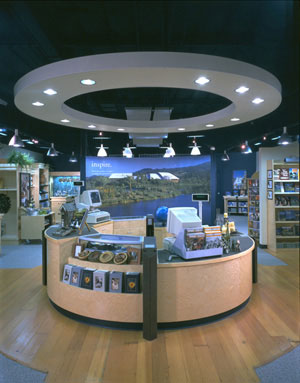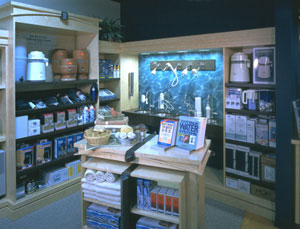
It's Only Natural
Real Goods creates "the greenest store in America"
By Chelsie Butler, Contributor
July 2000
It makes absolute sense. Wouldn't a retailer of renewable energy-driven and solar-powered products want to have the greenest, most environmentally friendly stores around?
Real Goods Trading Corp. (Santa Rosa, Calif.), established in 1978 as a catalog retailer for people with "independent" lifestyles, has a corporate mission it regards as its mantra: to promote a healthy and sustainable future. It's only natural, then, that Real Goods' stores be designed using the most environmentally benign products and materials available. "It was very important for us to walk the talk, to make the stores a physical example of our sustainable living principles," says Al Smiley, Real Goods' retail director.
The existing stores had a rustic, country-store look that catered primarily to solar technology customers—hard-core environmentalists. "Green design has had a stigma attached to it for years of looking unadorned and trashy," says Kent Lawson, principal of PRAIRIE FISH, the Chicago-based firm in charge of the prototype store design. "Our goal was to design a store that was sophisticated, elegant, comfortable, inspirational and enlightening, using more green materials than had ever been used before."
Green, But High Design
The new design caters to "cultural creatives." "These are people who care about the environment, but don't want to sacrifice design or aesthetics for it," says Lawson. "They still want to use their cell phones and laptop computers."
So, while the goal of the 3000-square-foot prototype, which opened last November in Los Gatos, Calif., was to be the "greenest store in America," it also had to look upscale enough to attract a mix of customers and fit into a variety of environments. The new look strays from unfinished materials toward light wood veneers with darker brown accents. The fixtures and materials are what Lawson feels people would be comfortable using in their own homes. The lighting gis energy efficient—using bulbs actually sold by Real Goods—yet dramatic. Drop pendants and recessed compact fluorescents in curved fixtures are used throughout. Lifestyle graphics draw customers into the space, while a mixture of carpeting and wood flooring offers warmth.
Designers set out to immerse customers immediately and completely in the sustainable environment. At the entrance, shoppers pass under a pergola flanked by waterfalls that cascade into basins made from recycled aluminum. "It provides a soothing transition from the outside 24/7 world into the Real Goods sustainable environment," explains Lawson. Inspirational graphics also help set the mood. A 17-foot photo mural mounted behind the store's central cashwrap depicts Real Goods' Solar Living Center in Hopland, Calif.
A compass rosette made of recycled tire rubber is inlaid in the wood flooring in front of the circular cashwrap, indicating the store's location on the earth and reinforcing Real Goods' educational directives with words like "Listen," "Teach," "Learn" and "Inspire."
Some of the store's more technical products need explanation, so the store includes informational graphics and several educational displays. For example, a water-testing area with four sinks offers six filters from which customers can taste different types of water, and a matrix shows each filter's level of filtration. At the lighting station, customers can test a variety of bulbs, and a sconce allows them to see what the bulb will look like with some shade. A "tech area" introduces alternative power sources.
Natural Origins
Lawson says environmental impact was considered in every aspect of the store; only environmentally sound materials were used. Fixtures are made from strawboard and covered in a veneer made from plantation-grown, sustainably harvested poplar. Shelves and part of the cashwrap are made from Environ™, a soybean and recycled newspaper composite material. Recycled aluminum was also used for display cases and brochure holders.
The carpeting features a 100 percent recycled backing with a dry bonding agent on the tile that eliminates the need for wet adhesives, which contain harmful organic compounds. Douglas fir reclaimed from a demolished warehouse was remilled into hardwood flooring. And the walk-off mat at the entrance is made from coconut husks, an agricultural waste product. Even the signage is sustainable. Recycled cardstock frames lifestyle photos, and signholders are made from the soybean and recyled newspaper mixture and reclaimed lumber.
Real Goods' combination of high design and earth consciousness is apparently paying off: Smiley says the Los Gatos store is performing well, and another store featuring the new design has opened in West Los Angeles. Revenues from Real Goods' six stores now comprise about 25 percent of the company's total sales volume, and the retailer plans to open two to three stores annually as part of a joint venture with Whole Foods, the world's largest marketer of organic foods and holistic health products.

The focal point of the Real Goods store is a circular cashwrap backed by a 17-ft. graphic of Real Goods' Solar Living Center in Hopland, Calif. Chicago-based PRAIRIE FISH, the store's designers, used only environmentally benign materials, including fixtures made from strawboard and wood veneer sourced from plantation-grown, sustainably harvested poplar.

Customers enter the Real Goods store through a pergola flanked by waterfalls. Higher-margin, softer products are located to the right of the entrance.

Some of Real Goods' more technical products need explanation, so informational graphics and hands-on testing centers are there to help. A large water graphic identifies the water testing area, where customers can taste water using different filters.

Real Goods is departmentalized, making the shopping experience easy and convenient. Departments are distinguished by hardwood pathways made from reclaimed, old-growth lumber. Lifestyle graphics also help shoppers find their way.
Client Design: Real Goods Trading Corp., Santa Rosa, Calif.—John Schaeffer, Founder and CEO; Al Smiley, Director of Retail Operations
Design: PRAIRIE FISH, Chicago, IL—
Kent Lawson & Richard Walthers, Principals
Liz Perez, Designer
General Contractor: Gen-Con, Campbell, Calif.
Lighting Design: Charter Sills & Assoc., Champaign, Ill.
Ceiling: USG Corp., Chicago
Countertops: Phenix Biocomposites, Mankato, Minn.
Fixtures: Contempo Design, Libertyville, Ill.
Flooring: Collins & Aikman, Dalton, Ga. (carpeting); Jefferson Recycled Woodworks, McCloud, Calif. (wood flooring); Dodge-Regupol (Gerbert Ltd.), Lancaster, Pa. (compass rosette); Ericson Group, Cleveland (coconut husk entrance mat)
Lighting: Halo Lighting, Elk Grove Village, Ill; Zumtobel Staff Lighting, Highland, N.Y.
Wall Graphics: Vomela Graphics, St. Paul, Minn..
Window Graphics: Photobition, Denver (formerly Cies Sexton, Denver).
This article appeared in the July 2000 issue of:
![]()